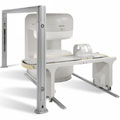 | Info
Sheets |
| | | | | | | | | | | | | | | | | | | | | | | | |
 | Out-
side |
| | | | |
|
| | | | |
Result : Searchterm 'Reconstruction' found in 7 terms [ ] and 47 definitions [ ] and 47 definitions [ ] ]
| previous 31 - 35 (of 54) nextResult Pages :  [1 2] [1 2]  [3 4 5 6 7 8 9 10 11] [3 4 5 6 7 8 9 10 11] |  | |  | Searchterm 'Reconstruction' was also found in the following services: | | | | |
|  |  |
| |
|
| |  | | | |  Further Reading: Further Reading: | | Basics:
|
|
News & More:
| |
| |
|  |  | Searchterm 'Reconstruction' was also found in the following services: | | | | |
|  |  |
| |
|
An undesirable background interference or disturbance that affects image quality.
The Noise is commonly characterized by the standard deviation of signal intensity in the image of a uniform object ( phantom) in the absence of artifacts. The measured noise may depend on the particular phantom used due to variable effects on the Q of the receiver coil. Noisy images appear when the SNR-Rate is too low - this is induced by the operator.
Image artifacts and RF noise can often be caused by the presence and/or operation of a medical device in the MR environment.
There are various noise sources in any electronic system, including Johnson noise, shot noise, thermal noise. Materials produce their own characteristic static magnetic field that can perturb the relationship between position and frequency essential to accurate image reconstruction.
RF noise, which often appears as static on the image, can be caused by a medical device located anywhere in the MR procedure room. RF noise is a result of excessive electromagnetic emissions from the medical device that interfere with the proper operation of the MR scanner. Since the MR procedure room is shielded from extraneous RF fields entering the room ( Faraday cage), operation of electromagnetically noisy equipment outside the room does not typically affect the MR scanner.
See Signal to Noise Ratio and Radio Frequency Noise Artifact. | |  | |
• View the DATABASE results for 'Noise' (86).
| | |
• View the NEWS results for 'Noise' (2).
| | | | |  Further Reading: Further Reading: | Basics:
|
|
News & More:
| |
| |
|  | |  |  |  |
| |
|
| |  | |
• View the DATABASE results for 'Number of Signal Averages' (5).
| | | | |  Further Reading: Further Reading: | News & More:
|
|
| |
|  |  | Searchterm 'Reconstruction' was also found in the following services: | | | | |
|  |  |
| |
|

From Philips Medical Systems;
the Panorama 0.23 T, providing a new design optimized for patient comfort, faster reconstruction time than before (300 images/second) and new gradient
specifications. Philips' Panorama 0.23 T I/T supports MR-guided interventions, resulting in minimally invasive procedures, more targeted surgery, reduced recovery time and shorter hospital stays. Optional OptoGuide functionality enables real-time needle tracking. Philips' Panorama 0.23 TPanorama 0.2 R/T is the first and only open MRI system to enable radiation therapy planning using MR data sets. The Panorama also features the new and consistent Philips User Interface, an essential element of the Vequion clinical IT family of products and services.
Device Information and Specification CLINICAL APPLICATION Whole body SE, FE, IR, FFE, DEFFE, DESE, TSE, DETSE, Single shot SE, DRIVE, Balanced FFE, MRCP, Fluid Attenuated Inversion Recovery, Turbo FLAIR, IR-TSE, T1-STIR TSE, T2-STIR TSE, Diffusion Imaging, 3D SE, 3D FFE, MTC;; Angiography: CE-ANGIO, MRA 2D, 3D TOFOpen x 46 cm x infinite (side-first patient entry) POWER REQUIREMENTS 400/480 V COOLING SYSTEM TYPE Closed loop chilled water ( chiller included) | |  | |
• View the DATABASE results for 'Panorama 0.23T™' (2).
| | | | |  Further Reading: Further Reading: | News & More:
|
|
| |
|  |  | Searchterm 'Reconstruction' was also found in the following services: | | | | |
|  |  |
| |
|
Device Information and Specification CLINICAL APPLICATION Whole body SE, FE, IR, STIR, FFE, DEFFE, DESE, TSE, DETSE, Single shot SE, DRIVE, Balanced FFE, MRCP, Fluid Attenuated Inversion Recovery, Turbo FLAIR, IR-TSE, T1-STIR TSE, T2-STIR TSE, Diffusion Imaging, 3D SE, 3D FFE, Contrast Perfusion Analysis, MTC;; Angiography: CE-ANGIO, MRA 2D, 3D TOFOpen x 47 cm x infinite (side-first patient entry) POWER REQUIREMENTS 400/480 V | |  | |
• View the DATABASE results for 'Panorama 0.6T™' (2).
| | | | |
|  | |  |  |
|  | | |
|
| |
 | Look
Ups |
| |